When Pebble Beach announces a special display, the enthusiast community immediately comes to life. No one who saw the six Bugatti Royales at Pebble Beach in 1985 will ever forget the spectacle. A class for Bugatti Type 57s with coachbuilt bodies in 2003 was extremely impressive, with a large entry and car histories on placards mounted on standards. (This article originally was published in September 2011.)
Ferraris also have had their days at Pebble. An exceptional turnout was guaranteed every ten years when Ferrari was the featured marque at the Monterey Historic Automobile Races and Pebble Beach added more classes for the products of Maranello. Hopefully, the Rolex Monterey Motorsports Reunion will continue this tradition. Other years have yielded some gems as well. In 2009, there were Pebble Beach classes for ten Ferrari 166 Barchettas and all four remaining 250 TR/59s. Last year, there were eight iterations of the 250 Short Wheelbase on the field.
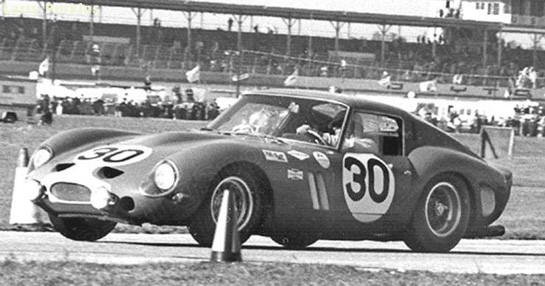
A contemporary image of 3223 GT at the 1966 Daytona 24 Hour. This is the livery as it appeared at Pebble Beach this year.
This year provided one of the best, if not the best, Ferrari entry ever, and the highlight was a 50th Anniversary class for 250 GTOs. It had 21 cars aligned along the shoreline. Heading the line on the right was Bruce McCaw’s 250 Sperimentale, one of two SWBs used in developing the GTO. There were also two four-liter GTO variants with hopped up Super America engines.
One of the GTOs, 3223 GT, had quite a week on the Monterey Peninsula. It was the first GTO built, and although there are a few dissenters, the overwhelming majority of historians feel it was the car presented at the February 24, 1962 press conference in Maranello when the model was introduced.
As the first GTO, the factory used 3223 as a development mule, rather than racing it. It was delivered to American Ferrari importer Luigi Chinetti at Le Mans in 1962 where it sat in the garage as a spare. It was then shipped to the U.S. and almost immediately sold to a stockbroker from an old Pittsburgh family, Bill McKelvy. McKelvy entered it for various drivers at Bridgehampton, Nassau, Sebring, Daytona and Marlboro in 1962-3.
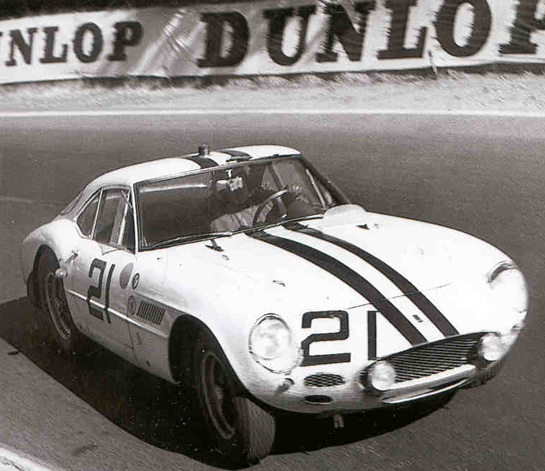
When no GTOs were ready, Stirling Moss drove this Ferrari 250GT Sperimentale Ferrari, S/N 2643GT to 4th Overall and 1st in GT at Daytona in 1962. This was the first race where GTs scored Championship points. In 1962, it was owned by Bill McKelvy and driven by Ed Hugus, who drove the car with George Reed at both Sebring and Le Mans; the latter is pictured here. Ed Hugus Collection.
In the fall of 1963, dealer/racer Bob Grossman and Charley Hayes drove the car for McKelvy in that year’s final FIA GT Championship race at Bridgehampton where they finished 10th and first in class. Grossman then bought 3223 for $5500 and raced it at Mosport.
By 1964, the car was owned by Larry Perkins who drove it at Daytona and Sebring in both 1964 and 1966. Sometime in 1966, the car again went to Grossman, this time for $3600. It drifted through various hands, including long term owners Bob Bodin (25 years) and Yoshikuni Okamoto in Japan (10 years).
Now owned by Scuderia DiBari, the car emerged at Pebble Beach this year as part of the GTO 50th Anniversary class. Accompanying it was an old friend, octogenarian, retired aerospace engineer and accomplished sculptor, Larry Perkins. He became reacquainted with the car and dug through the Daytona archives to advise on the restoration of 3223. As the restoration progressed, Perkins made sure all the details were correct right down to the Tech Inspection decal on the windshield, one of his many finds in the Daytona files.
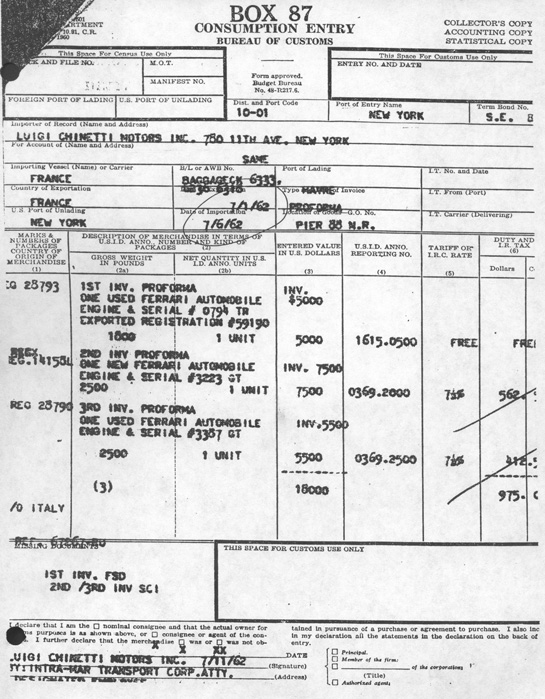
This bill of lading shows that 3223 GT was shipped from France after Le Mans 1962 on the ocean liner of the same name. Note that the cars were shipped as baggage. One was shipped free. Accompanying 3223 was another GTO, 3387 and the Ferrari 250 TR/61 0794 that had been crashed at Le Mans that year. Credit: David Seielstad Archive.
Perkins’ adventures with the car in period were many, and as a great story teller he loves to relate them. He was always trying to hustle sponsorship money when he was racing. When he took the GTO to Daytona in 1964, it was a 2000 km event. Perkins found local Pontiac dealer Al Hodges, who was willing to sponsor the car if Perkins would leave it in his showroom next to a Pontiac GTO during the run up to the race. Hodges evidently sold three Pontiac GTOs during this display, leading to painting the dealer’s name on the flanks of the Ferrari.
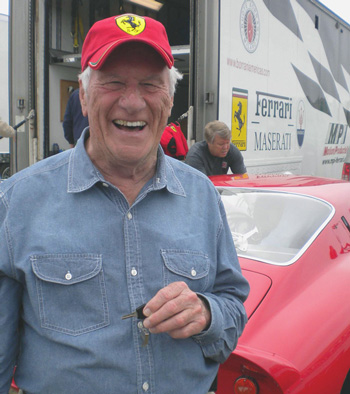
Larry Perkins is in a good mood as GTO 3223 is unloaded in the polo field staging area at Pebble Beach. Credit: Carol Seielstad.
When the car showed up at the track, Luigi Chinetti was livid. He told Perkins that Ferraris did not carry that kind of advertising. Not knowing how to respond, Perkins went to Bill France, the founder of NASCAR. The conversation was short and to the point.
France asked, “Did Chinetti give you any money to run the race?” Perkins answered no. France then inquired, “Did the Pontiac dealer give you any money to run the race?” Perkins answered yes. “Well”, said Big Bill, “I own this track, this is my race and Al Hodges is a friend of mine. My opinion is you can do whatever you want with your car.” Perkins did, and this set the stage for a long list of frustrations when Chinetti closed the parts window on him for the duration of his ownership.
Driving with Bill Eve in 1964, Perkins had battery and generator problems, leading to a mid-race swap by Prestolite personnel who took out the generator and substituted an alternator, costing 40 minutes. The GTO finished 11th overall and 9th in class at Daytona that year. Five weeks later, he and Eve tackled Sebring where Perkins ran out of brakes. Coming into the pits, with no radio to warn the crew, Perkins slowed the car with the gearbox, but still had to scrape the pit wall to stop and he ran into the jack handle of Ed Cantrell’s GTO (3767) that was elevated on a floor jack. Despite this mishap, Perkins and Eve went home with a 3rd in class, driving the remainder of the race with front brakes only.
After that, the car went to John Sabiston’s shop on Long Island where it was rebuilt, including fixing the front end damage. Because he couldn’t get the Ferrari parts, orange Porsche parking lights were used in the front body reconstruction. They remained on the car during Perkins’ ownership and the present restoration reflects this. Perkins found maintenance on the Ferrari expensive and sponsorship thin and parked the car for 1965.
In 1966, Perkins and fellow racers Jack Slottag and Russell Beazell came up with the finance to return to Daytona, which was now a 24-hour race. The GTO was placed in the under three-liter sports class as the FIA had changed the rules for GT cars, requiring 500 examples to be built. GT cars also no longer scored points toward the championship.
During practice, Beazell, who was 6’ 5”, realized he wasn’t going to be able to maintain the necessary contorted position to fit in the car for a full driving stint, so he stood down and ran the pits.
The stock car boys said the sporty car drivers were nuts to run wire wheels on the banking, but there was no other choice. Perkins had 14 wheels which had come with the car. Russ Beazell contributed another 4 wheels from his Ferrari 330 2+2, which was left on jack stands. The 18 wheels were rotated during the race in order to limit the time each set was used. There were no wheel collapses such as the one Mike Gammino’s GTO (3387) suffered in practice at Daytona in 1964.
The two GTO rectangular driving lamps proved inadequate, especially on the back straight banking which had no illumination. After talking with the various providers at the track, a powerful pencil beam driving lamp was fitted on the right as well as a broader floodlight on the left with a wide beam that allowed the driver to see exactly how close the car was to the banking wall at night. The latter came in handy as it was one of the coldest races on record and there was frost, if not ice, at the top of the banking at times during the darkness. The cold also caused Perkins’ crew to close one of the three nose flaps on the GTO.
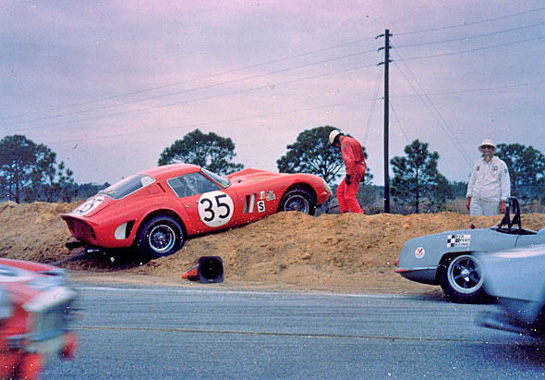
Jack Slottag surveys the result of what came to be known as the 'Gucci Incident' while an Elva and MG continue through the Sebring hairpin in 1966. Larry Perkins Collection.
The reconfigured car was ready to go on grid for the Saturday afternoon start. During a night pit stop, the car would not restart despite all the tricks including starter fluid. A valve adjustment on the hot engine was performed and the problem was solved. Perkins and co-driver Jack Slottag persevered, not only to the finish, but to become a major footnote to Ferrari history. Their 1966 victory in the three liter sports class was the last great international victory for the GTO.
Sebring that year saw a new financial arrangement with Firestone, who were trying to break into road racing. Perkins had previously had a relationship with Goodyear, but Firestone offered a better financial package and that led to body modifications to accept wider Firestones. Ken Jeffers pounded out the fenders with a knock-off hammer meant for wheel nuts.
Perkins again teamed up with Jack Slottag. Slottag practiced in tennis shoes, but they were too hot and tended to slip on the pedals, so he switched to a pair of Gucci loafers. This was not unusual for the day, but the Guccis had an especially high heel. I happen to have a pair of Guccis of that vintage, and the heels on mine are 1’ 3/8” high. The heels and the fact the GTO had an extension on the gas pedal to make heel and toe simultaneous braking and shifting caused a problem.
Around the fifth hour, Slottag came into the braking area at the hairpin with following traffic. When he hit the brakes, he also inadvertently hit the accelerator tab with the heel of his Gucci. This lengthened his braking zone enough to cause him to miss the line through the hairpin and run the car into the sandbank there deep enough so that it couldn’t be backed out. Although many competitors over the years had dug their cars out at this location, the oncoming traffic was extremely threatening. Ultimately, course workers were requested to help Slottag get the car moved. At that point, the car was retired because of outside assistance. 3223’s days in major international racing were over. The car’s last period race was an SCCA National with Perkins at Daytona on 4 September 1966 where he finished 5th overall and second in class.
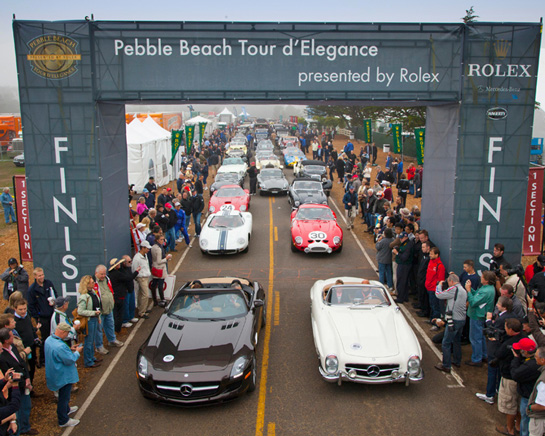
The start of the Pebble Beach Tour d’Elegance at the Polo Field on Thursday; Sir Stirling and Susie Moss are in the 300 SL to the right, with David Seielstand and Alan Boe in the Ferrari GTO (#30) right behind. The route takes the entrants down the coastal road to Big Sur and back. The Tour stops in Carmel for lunch and then continues back to Pebble Beach. It is one of the great spectacles of the week. Courtesy Kimball Studios, Pebble Beach Concours d'Elegance
When the car was being restored by Motion Products of Neenah, Wisconsin, Perkins became aware of the plans for 3223 to come to Pebble Beach. To prepare for this year’s Holy Week on the Monterey Peninsula, Perkins dug out his fireproof underwear and driving suit. The former fit, the latter didn’t. A call to Hinchman Raceware in Indianapolis soon paid off. Hinchman has files on all uniforms it has made, dating back to 1925 and was able to provide the design information Perkins needed to have a replica uniform made elsewhere. Perkins was with the car most of the week and amused the crowds with stories of his days with 3223.
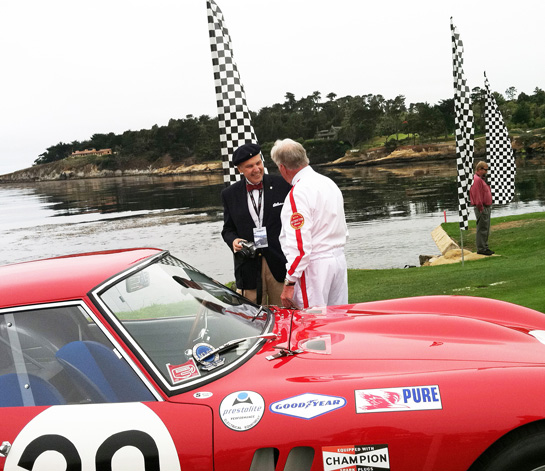
The author gets the full story from Larry Perkins on the lawn at Pebble Beach. Perkins relates how the decals on the car had to be Photoshopped from period photos, as there were no accurate ones available. Credit: Vicki Lynch.
The car made some new friends in Alan Boe and David Seielstad this year. Boe is the Chief Ferrari Judge at Pebble Beach and Seielstad has judged Ferraris there for years.
Last year David drove a Scuderia DiBari 250 Short Wheelbase Competition car on the Pebble Beach Tour d’Elegance. This year, he was given the responsibility of driving the GTO and Boe joined him as passenger.

Alan Boe (l) and David Seielstad answer questions about their time on the road in the GTO at the Carmel lunch stop during the Pebble Beach Tour d’Elegance. Credit: Carol Seielstad.
The duo was somewhat of an anomaly in the GTO, as they are known as the two most knowledgeable historians of the Ferrari 250 SWB series. They left Pebble Beach at the start of the tour right behind Sir Stirling Moss in a 300 SL. As they proceeded, the leading Highway Patrol motorcycle officer dropped back to hold traffic. Moss was off like a shot and Seielstad gave the GTO full throttle. After arriving in Carmel for the lunch stop, David and Alan were joined by David’s wife, Carol. When coming into Carmel, David had revved the engine to clear the carbs and plugs after a lot of slow running. Carol said she was momentarily napping in their hotel room several blocks away and was awakened by the sound of the GTO. At that point, David confessed that the team had seen 4500 RPM in 5th gear on the road. When Carol asked why, David replied, “I was just trying to keep up with Sir Stirling.”
Although both David and Alan are partial to SWBs, both have driven GTOs and are in agreement that while an SWB is a fine Ferrari, the GTO is in another dimension both in terms of power and handling. It seems there is substance behind the legend.
On the lawn at Pebble Beach Sunday, David and Alan were working and Larry Perkins was looking after the car. He had on his new driving suit and was kind enough to spend some time bringing me up to date on many details about the 1966 Daytona 24 that I had either forgotten or never knew, although I was there.
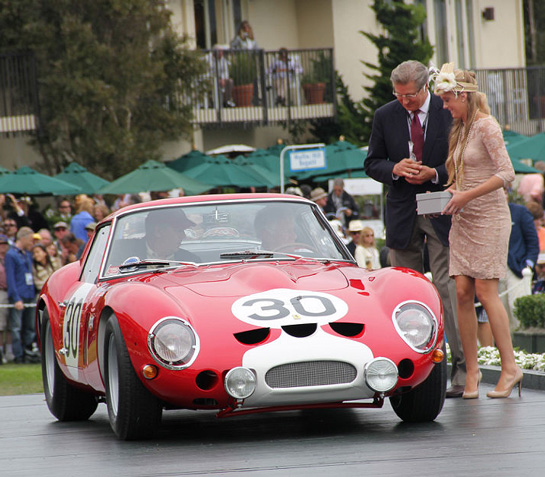
At the end of a special week, GTO 3223 crosses the ramp for the second time to receive the Strother MacMinn Trophy, awarded to the Most Elegant Sports Car. The first GTO is first again. Credit: Hugues Vanhoolandt.
The climax of the day for all of us was when Larry drove 3223 over the ramp with historian Marcel Massini aboard to win the 50th Anniversary of the Ferrari GTO class. Later that afternoon, Perkins and 3223 were on the ramp again, this time with Wayne Obry of Motion Products, to accept one of the four most prestigious Special Awards, the Strother MacMinn Trophy for Most Elegant Sports Car. 45 years after GTO 3223 GT’s victory at Daytona in 1966, she was back in the winner’s circle again, and Larry Perkins was with her, just as he was then.
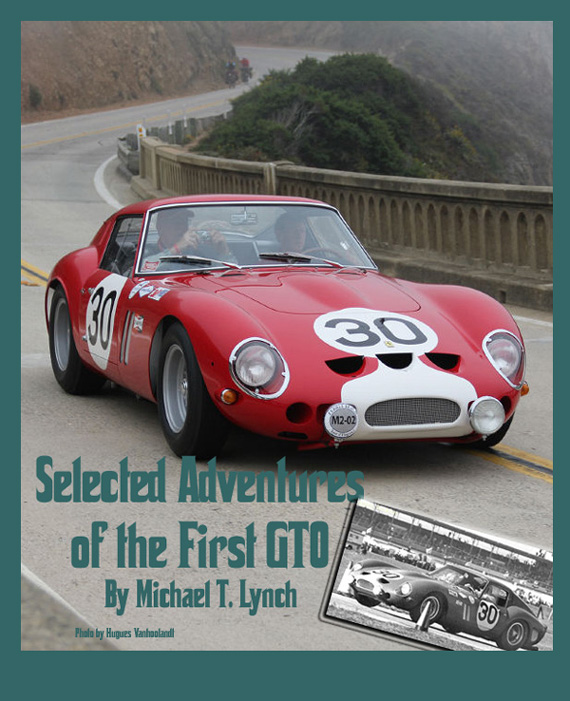
I can’t add anything to Michael’s details on chasis 3223, but surely the shot of the #21 experimental chassis 2643 was taken at Le Mans in 1962, not 1963.
Caption was incorrect and now fixed. The year was 1962 as you state. Editor’s fault not author’s. We’ll try to pin something on him though!
Pete
In the just wondering department, as a college kid from Waukegan Illinois in the early 1970’s I often hung out at the local import dealer. Sorry I can’t remember the dealership name exactly (International Imports?) but I think it was on West Belvedere Ave. Anyway, the dealership owner had quite a few concourse level saloon cars and his son had acquired a 1962 (?) SWB (I think) GTO, which he raced in some historic races. I probably have pix of it at Blackhawk Farms or Elkhart Lake some place, but finding them…. Further, the son told me it was one of 6 cars that were taken to LeMans, but that it was a spare and not entered. Might anyone know where this car ended up? Thanx, Gary
Michael:
Wonderful article on a very special car. Thank you. But I just can’t get out of my head the image of 3223 painted with a Pontiac dealership ad. That’s something you might have seen in MAD magazine!
Mary Ann
Mary Ann – I know it sounds crazy nowadays, when the car is iconic. And it sounded crazy to the NART folks at the moment, when their GT Ferrari customers were largely “gentleman drivers”. But I assure you that, to a hungry SCCA-based racing team, in search of international recognition on the track (and maybe a ride, down the road), it made perfect sense. Al Hodges was very active in the early NASCAR years, and frequently ran cars emblazoned with his logo at friend Bill France’s new Daytona Speedway. His dealership had just taken delivery of one of the first namesake Pontiac GTOs, which he was anxious to promote. We had acquired the car from Bob Grossman just 6 weeks prior, in very tired condition, and needed local garage space and a dyno to prepare for a 13-hour race. With Al’s generous support, it was a no-brainer to have his stock car painter put a huge “Al Hodges, Cocoa, Florida” on the fenders. The unexpected reaction from the gentlemen racers was a set-back, but we did pretty well, all things considered. We were fast in practice, we finished well (11th OA, while plenty of big teams DNF’d), and our performance prompted my future friend Phil Hill to come over and ask, incredulously, “Who ARE you guys?!”
Thanks for your thoughts, and your interest in Michael’s excellent work.
Sincerely,
Larry
Larry:
Thanks for the additional explanation. It all still is amazing to me. And getting to know Phil Hill over it is certainly a great part of the story!
Just between you, me and the lampost the car should have been restored in the 1962 Press Confrence livery.
Finally saw my first 250GTO in July In the Maranello Ferrari museum. Its taken me 40 years, but it was worth the wait. Such a beautiful car!
I know this story has been out there for awhile, but it’s the first time I’ve read the article. While I was young at the time, I have vivid memories of this car being driven away from the track at Daytona, on the streets! Imagine that now. If only my father (Ken Jeffers) knew how iconic this car would become, maybe he would have thought twice about hammering the fenders out.